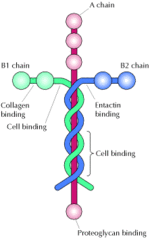Laminin
Från Rilpedia
Laminin är den huvudsakliga icke-kollagiena komponenten i basal lamina ... such as those on which cells of an epithelium sit.[1] Basically, laminin is a protein found in the "extracellular matrix", the sheets of protein that form the substrate of all internal organs also called the "basement membrane". It has four arms that can bind to four other molecules. The three shorter arms are particularly good at binding to other laminin molecules, which is what makes it so great at forming sheets. The long arm is capable of binding to cells, which helps anchor the actual organs to the membrane.
The laminin protein is made up of three separate parts, called the A, B1, and B2 chains. That gives it a total of six "ends", which accounts for a lot of its flexibility in connecting up various kinds of molecules. Because of this, scientists who create biomaterials are extremely interested in the whole family of laminins. They are a family of glycoproteins that are an integral part of the structural scaffolding in almost every animal tissue. Laminins are secreted and incorporated into cell-associated extracellular matrices.
Laminin is vital to making sure overall body structures hold together. Improper production of laminin can cause muscles to form improperly, leading to a form of muscular dystrophy. It can also cause progeria.
Innehåll |
Types
Each laminin molecule is a heterotrimer assembled from alpha-, beta-, and gamma-chains.[2]
Fifteen laminin trimers have been identified.
Networks
Laminins form independent networks and are associated with type IV collagen networks via entactin, and perlecan. They also bind to cell membranes through integrin receptors and other plasma membrane molecules, such as the dystroglycan glycoprotein complex and Lutheran blood group glycoprotein.[1] Through these interactions, laminins critically contribute to cell attachment and differentiation, cell shape and movement, maintenance of tissue phenotype, and promotion of tissue survival.[1][2] Some of these biological functions of laminin have been associated with specific amino-acid sequences or fragments of laminin.[1] For example, the peptide sequence [GTFALRGDNGDNGQ], which is located on the alpha-chain of laminin, promotes adhesion of endothelial cells.[3]
Pathology
Dysfunctional structure of one particular laminin, laminin-2, is the cause of one form of congenital muscular dystrophy[4]. Laminin-2 is composed of an α2, a β1 and a γ1 chains. This laminin's distribution includes the brain and muscle fibers. In muscle, it binds to alpha dystroglycan and integrin alpha7-beta1 via the G domain, and via the other end binds to the extracellular matrix.
References
- ↑ 1,0 1,1 1,2 1,3 M. A. Haralson and John R. Hassell (1995). Extracellular matrix: a practical approach. Ithaca, N.Y: IRL Press. ISBN 0-19-963220-0.
- ↑ 2,0 2,1 Colognato H, Yurchenco P (2000). "Form and function: the laminin family of heterotrimers". Dev. Dyn. 218 (2): 213–34. DOI:<213::AID-DVDY1>3.0.CO;2-R 10.1002/(SICI)1097-0177(200006)218:2<213::AID-DVDY1>3.0.CO;2-R. PMID 10842354.
- ↑ Beck et al., 1999.
- ↑ Hall, TE et al (2007). Proc Natl Acad Sci USA 104 (17), 7092-7097 doi: 10.1073/pnas.0700942104
